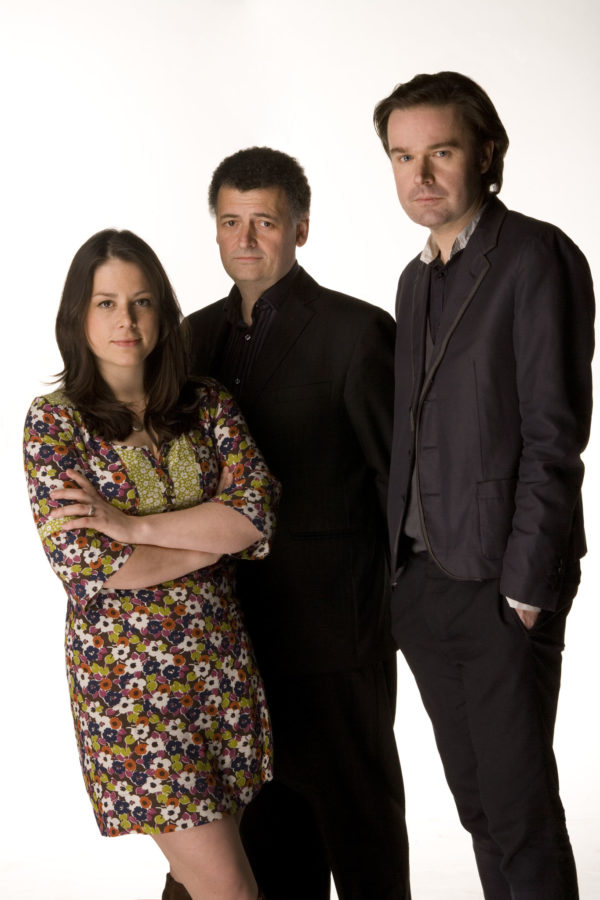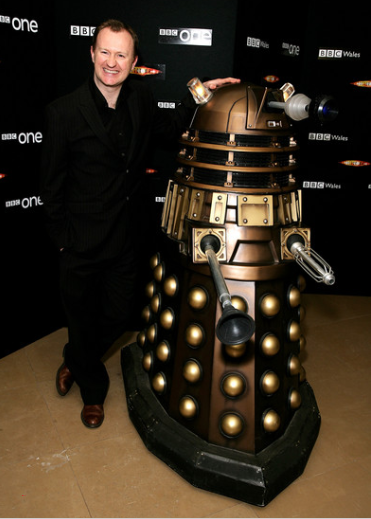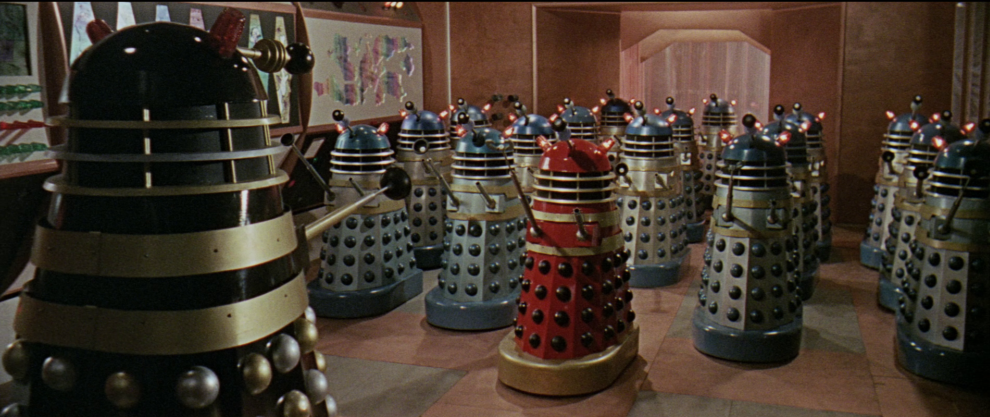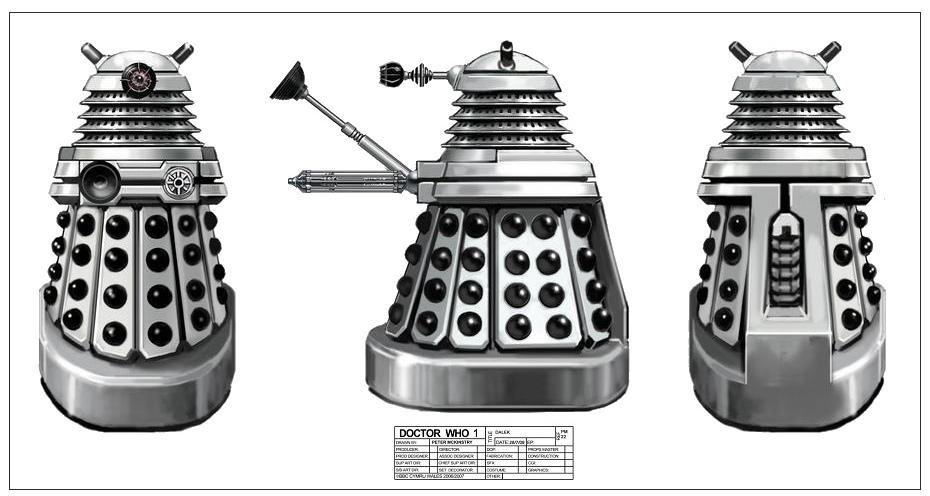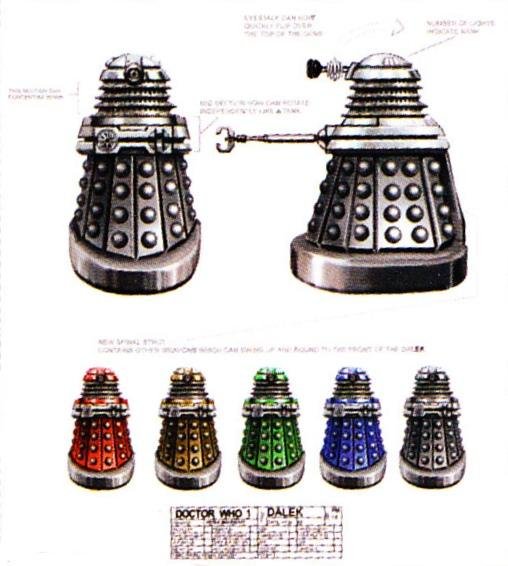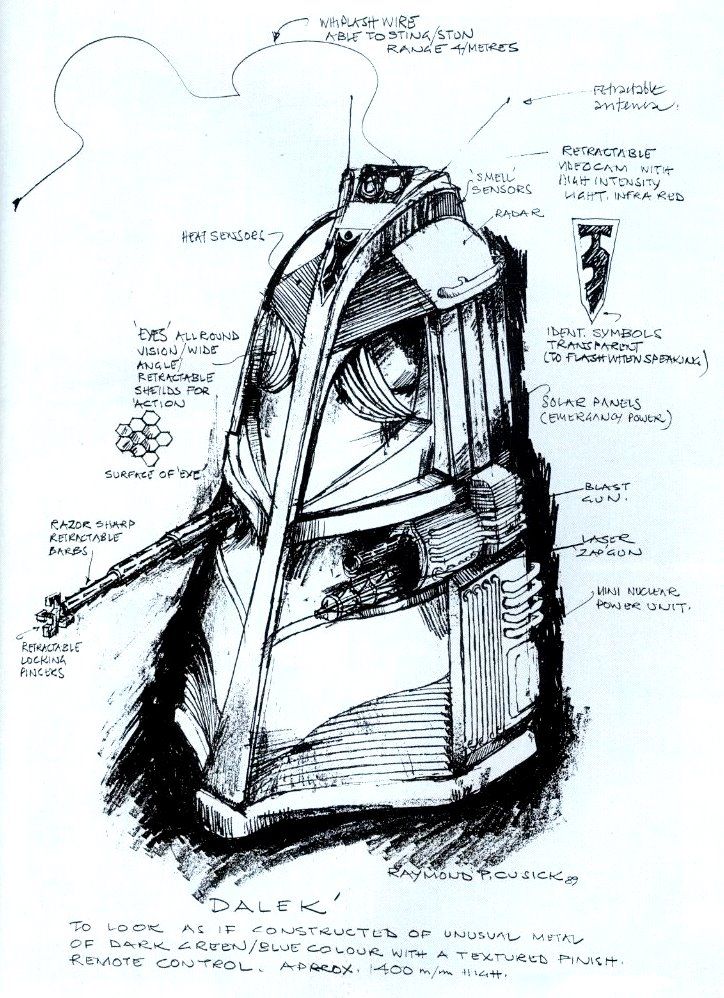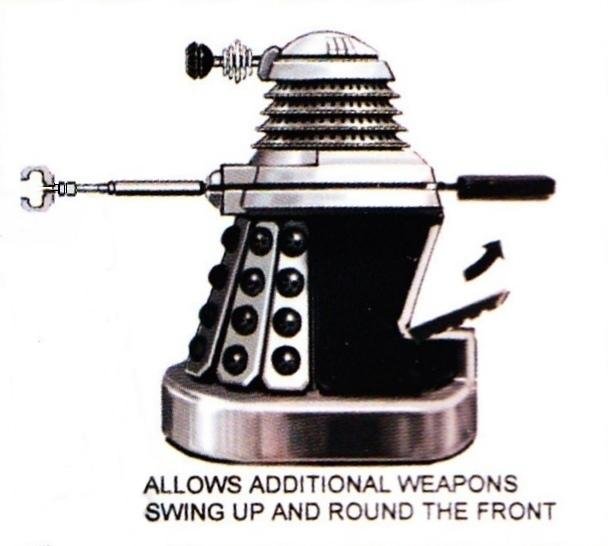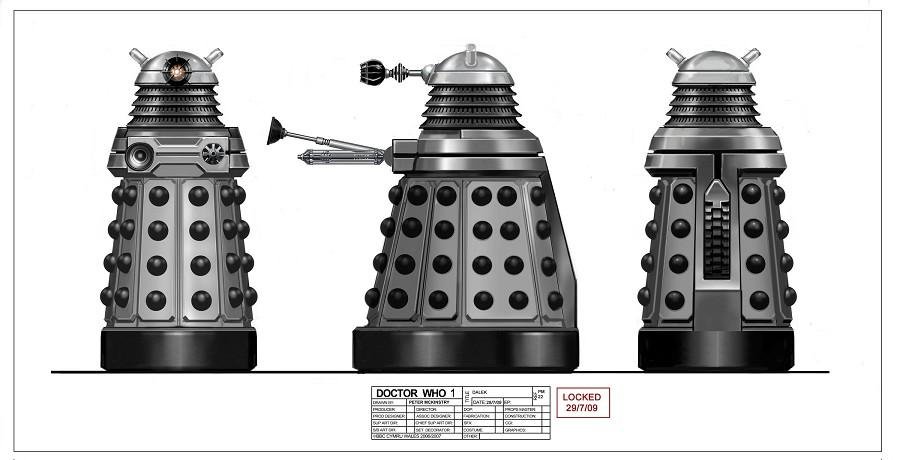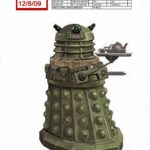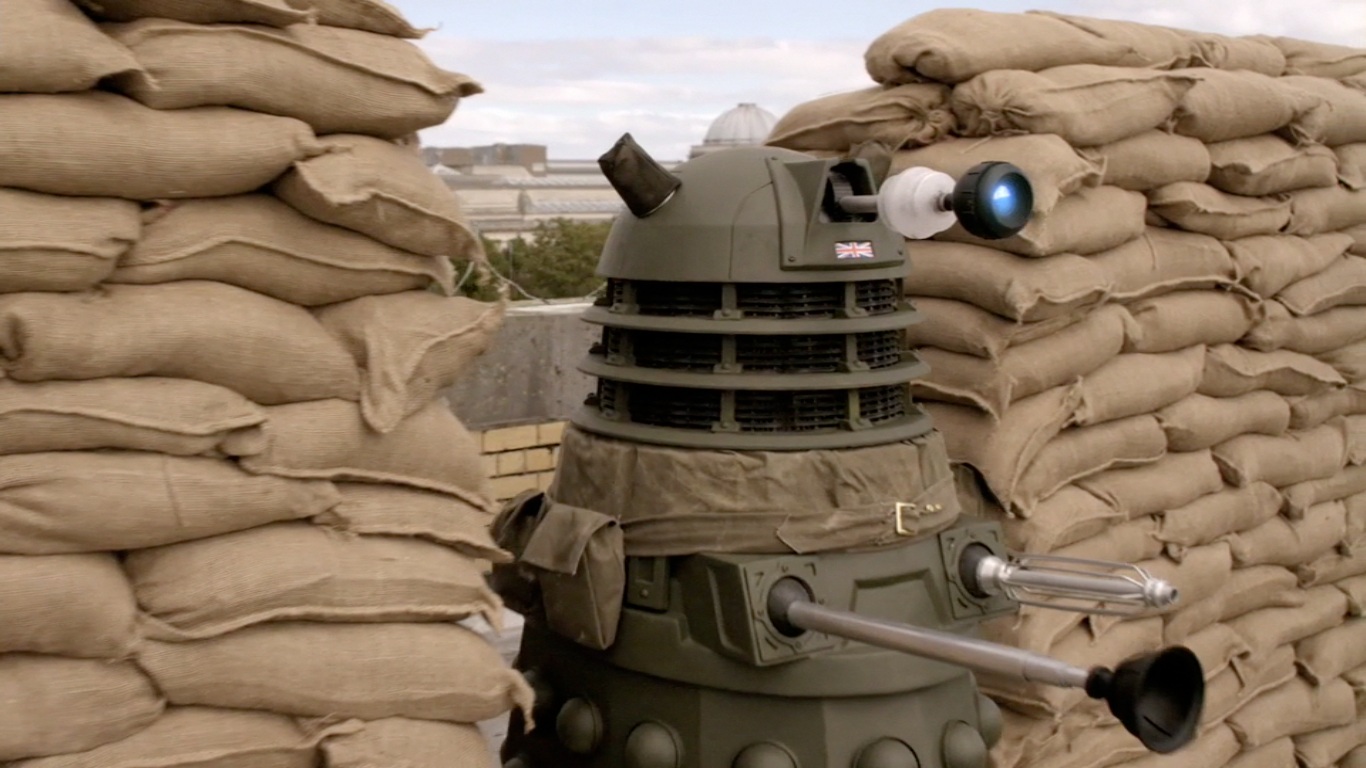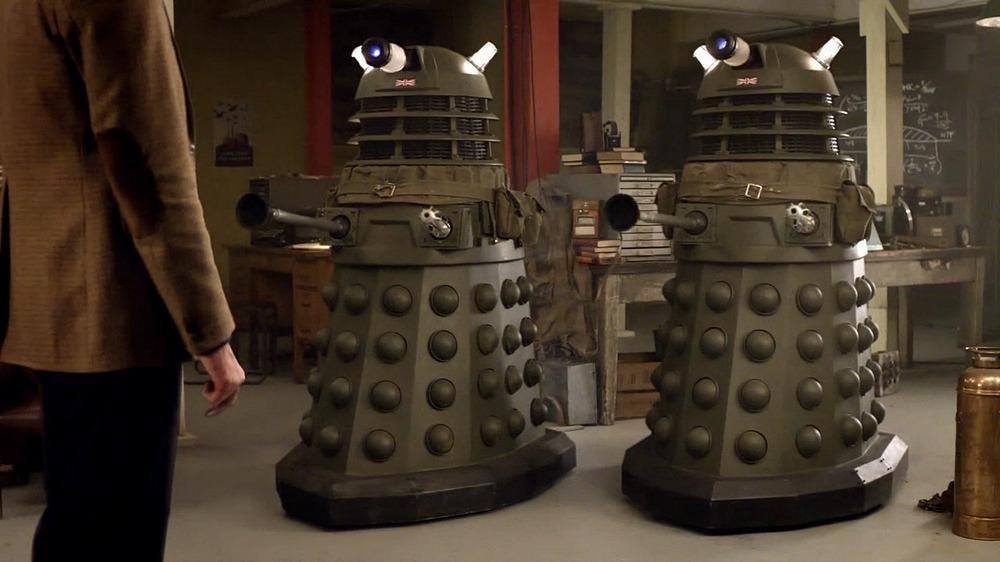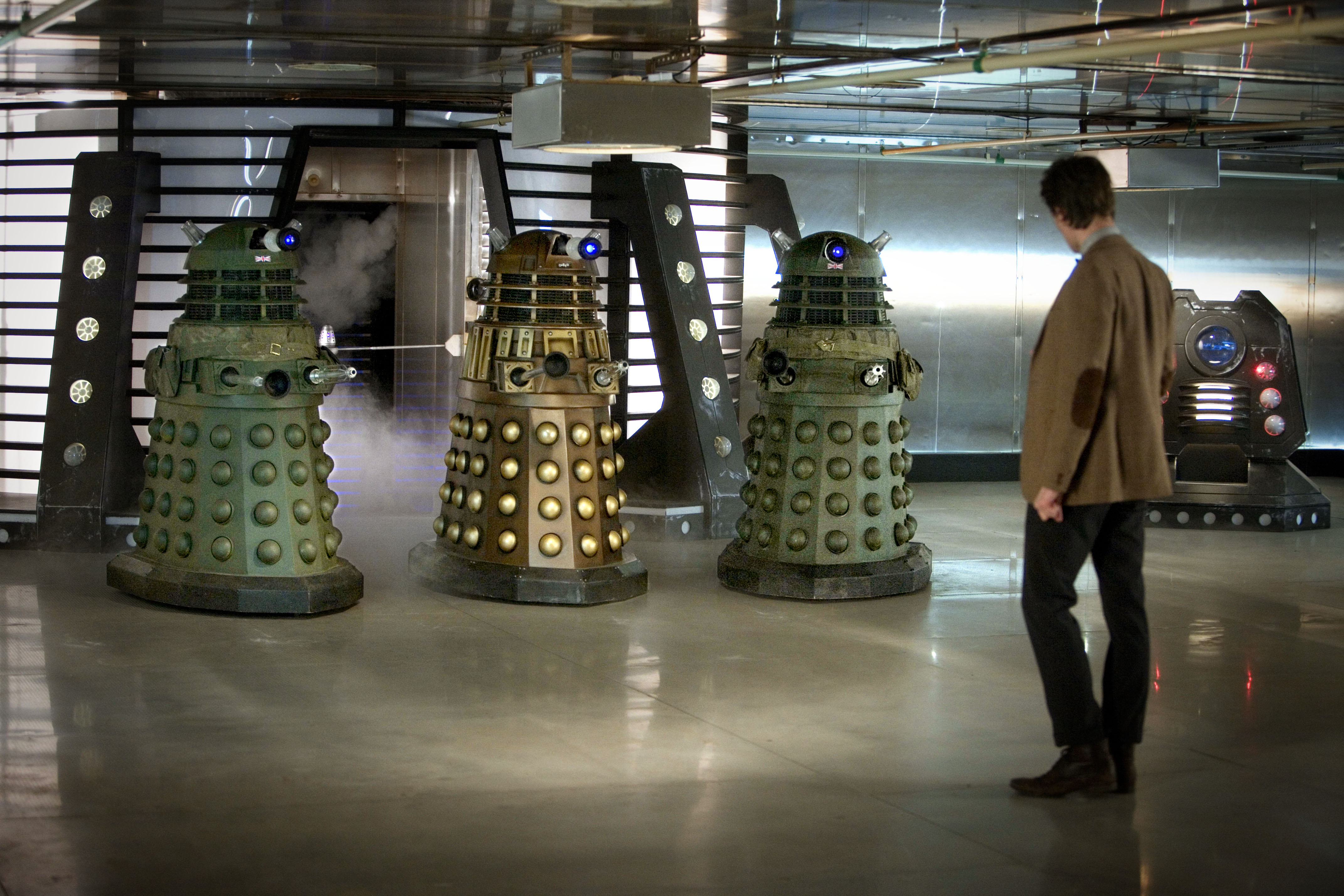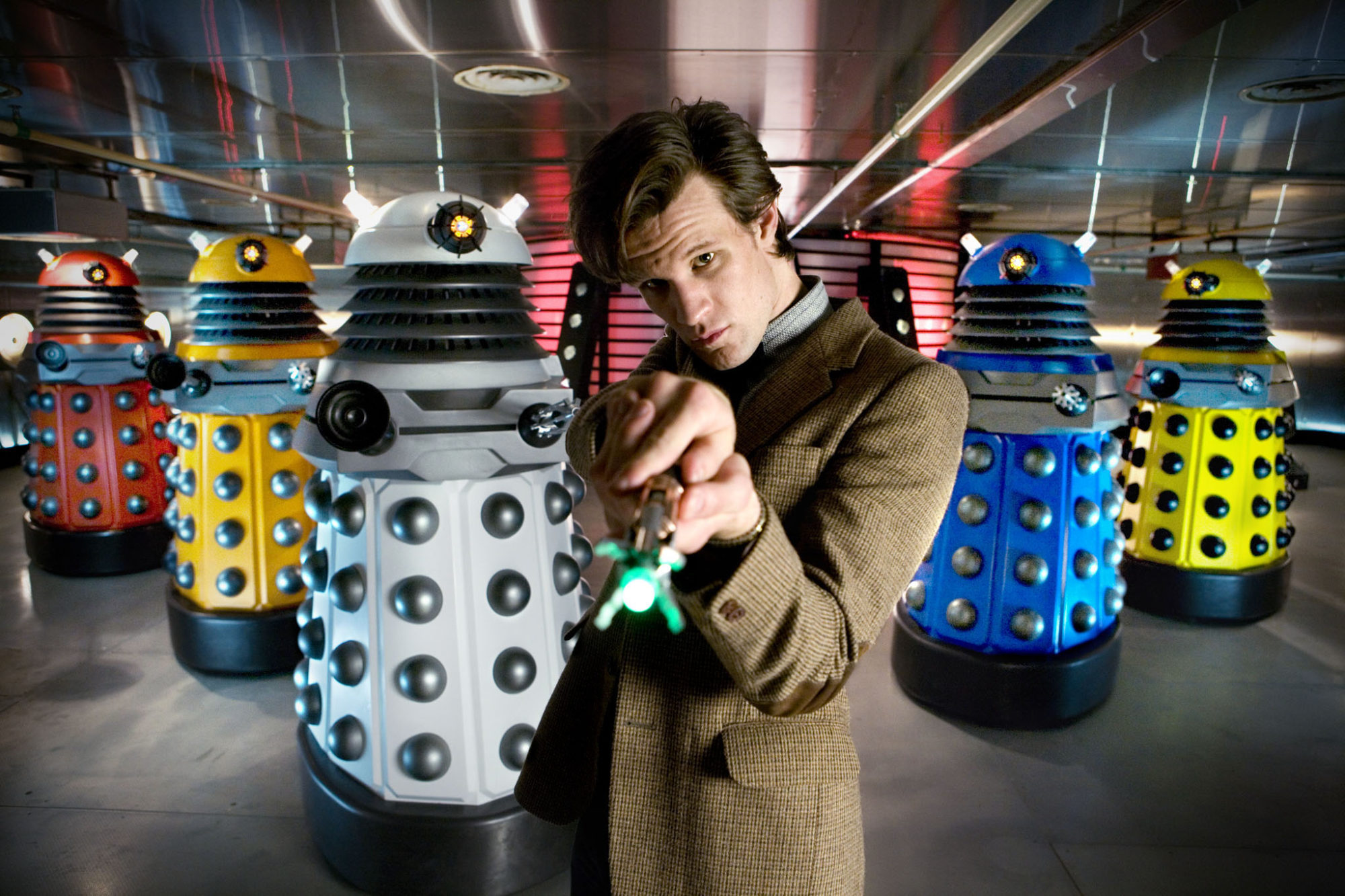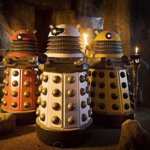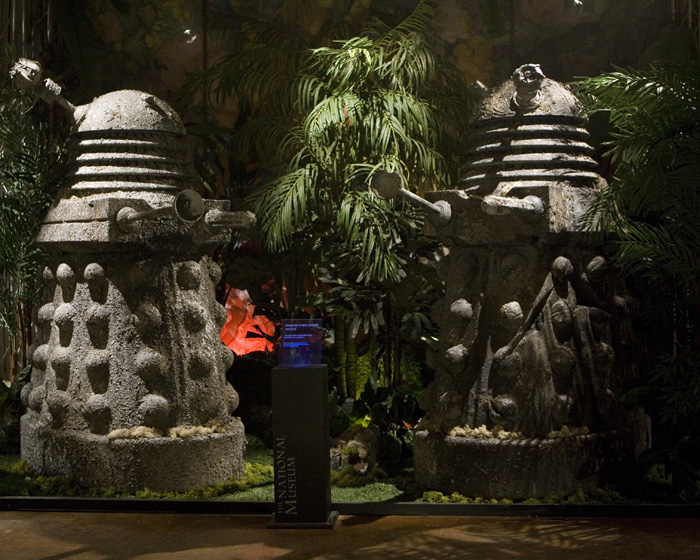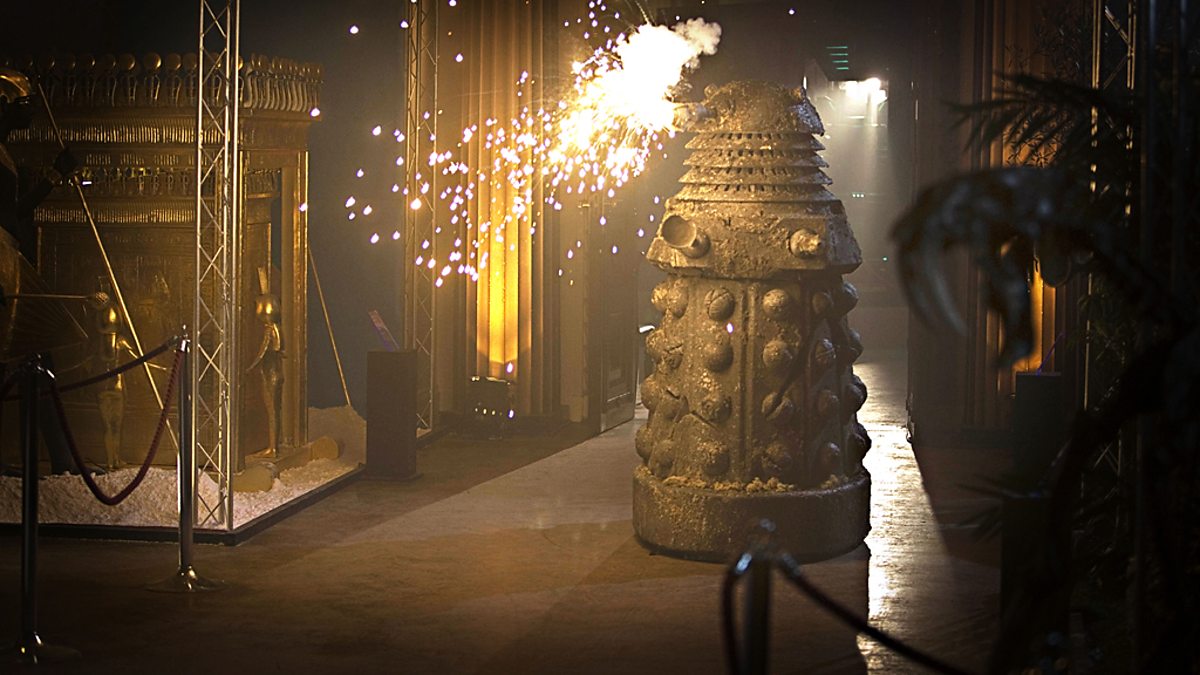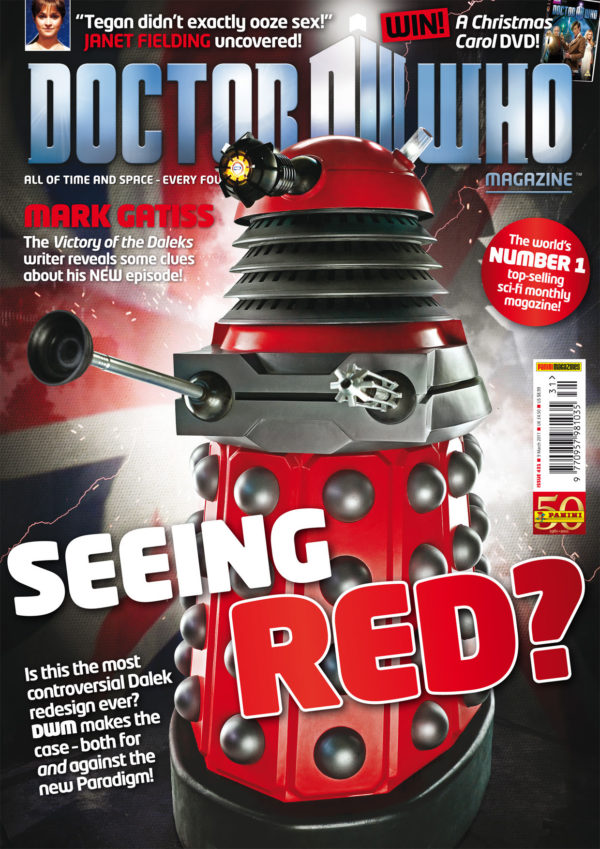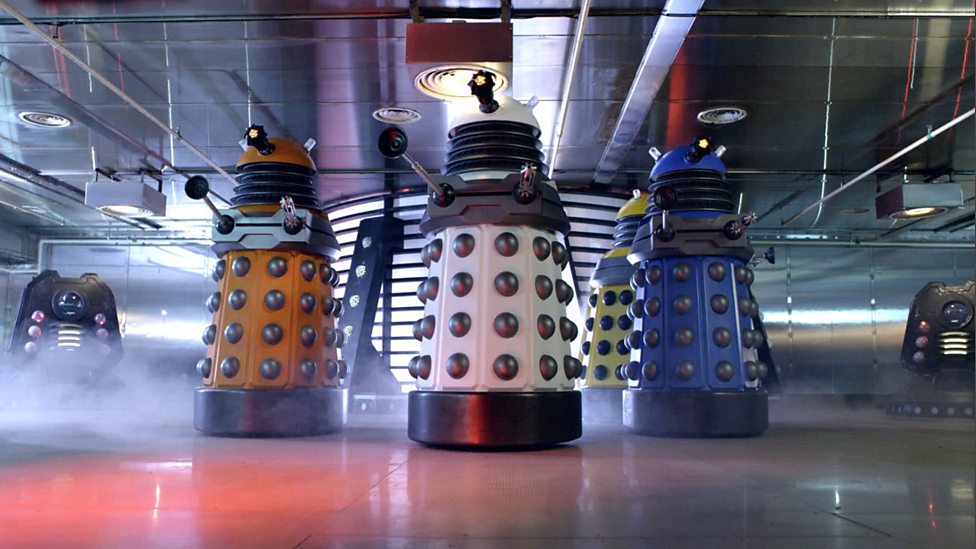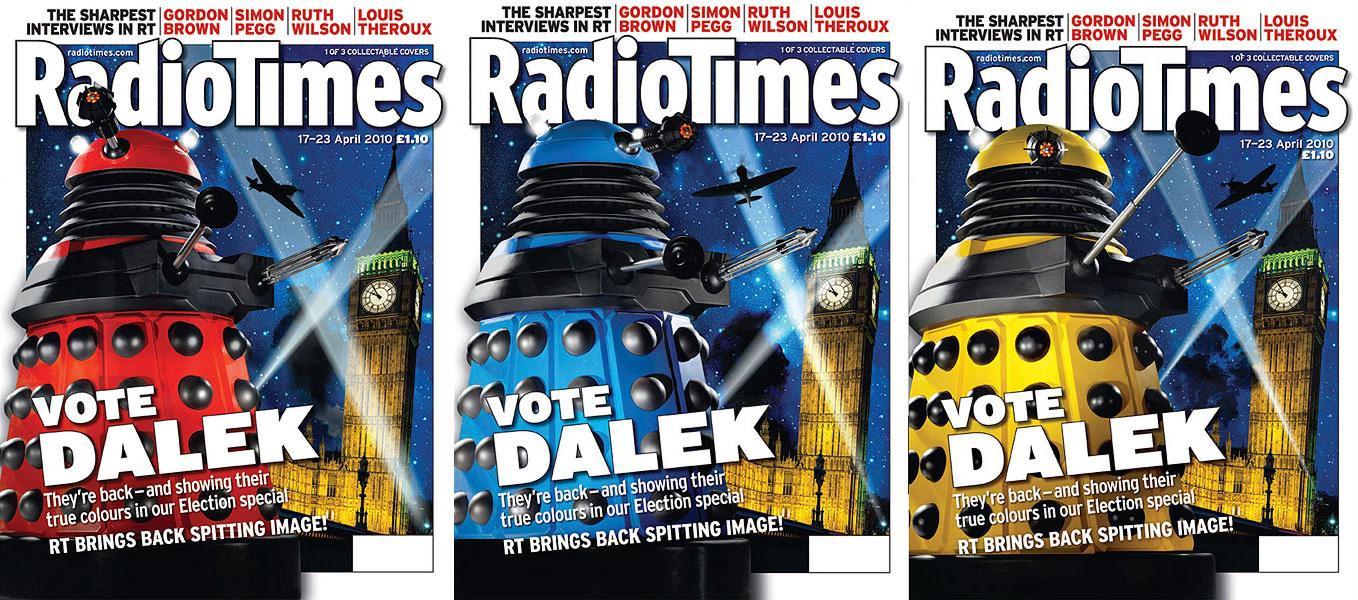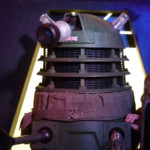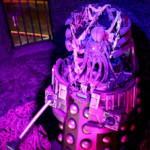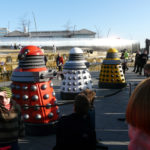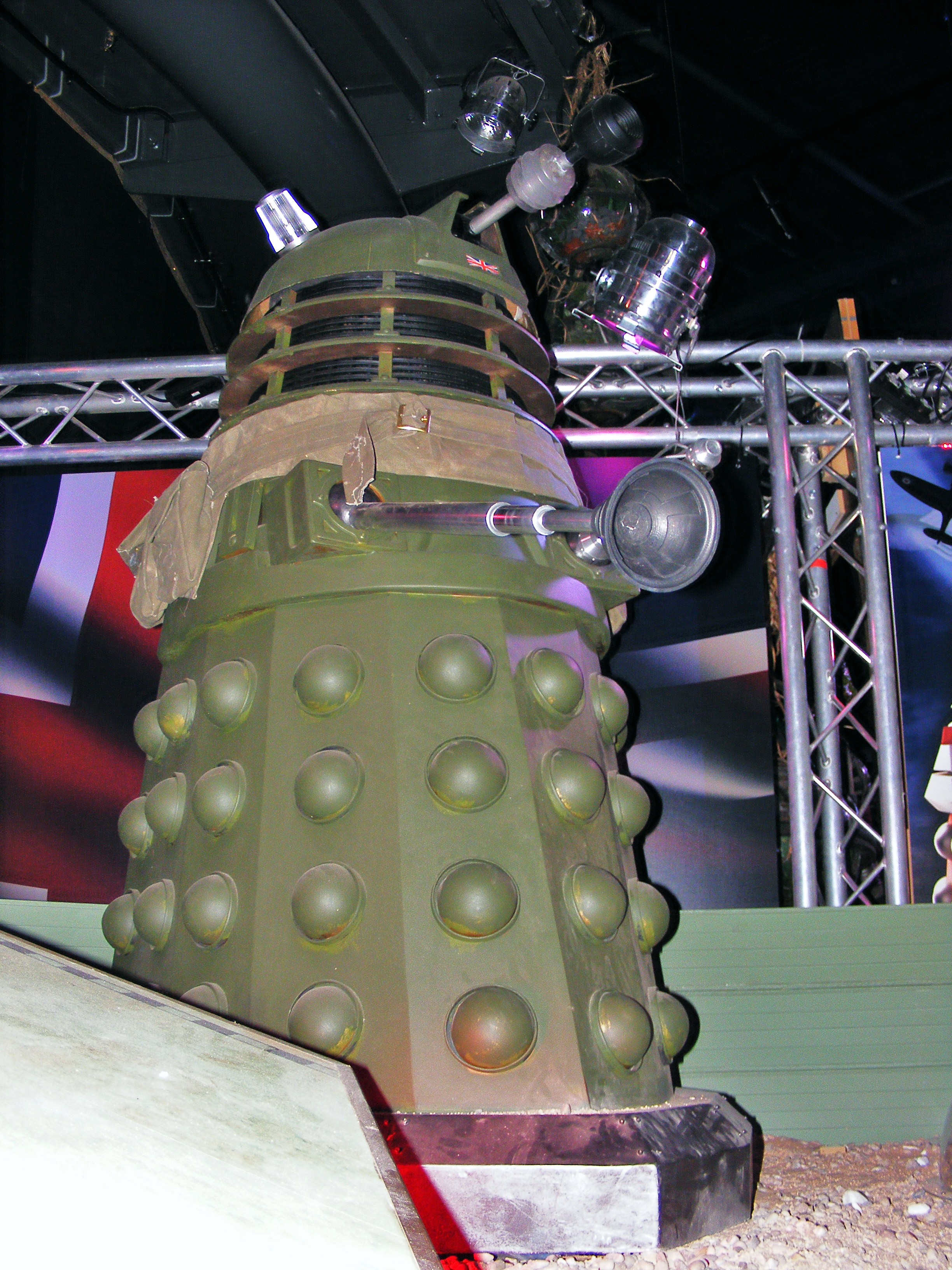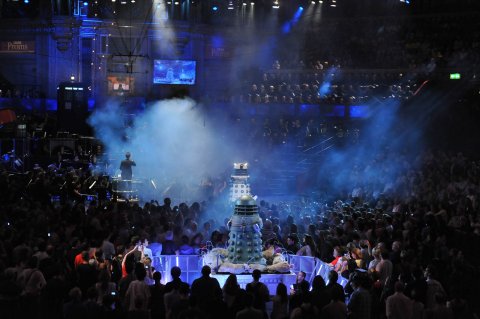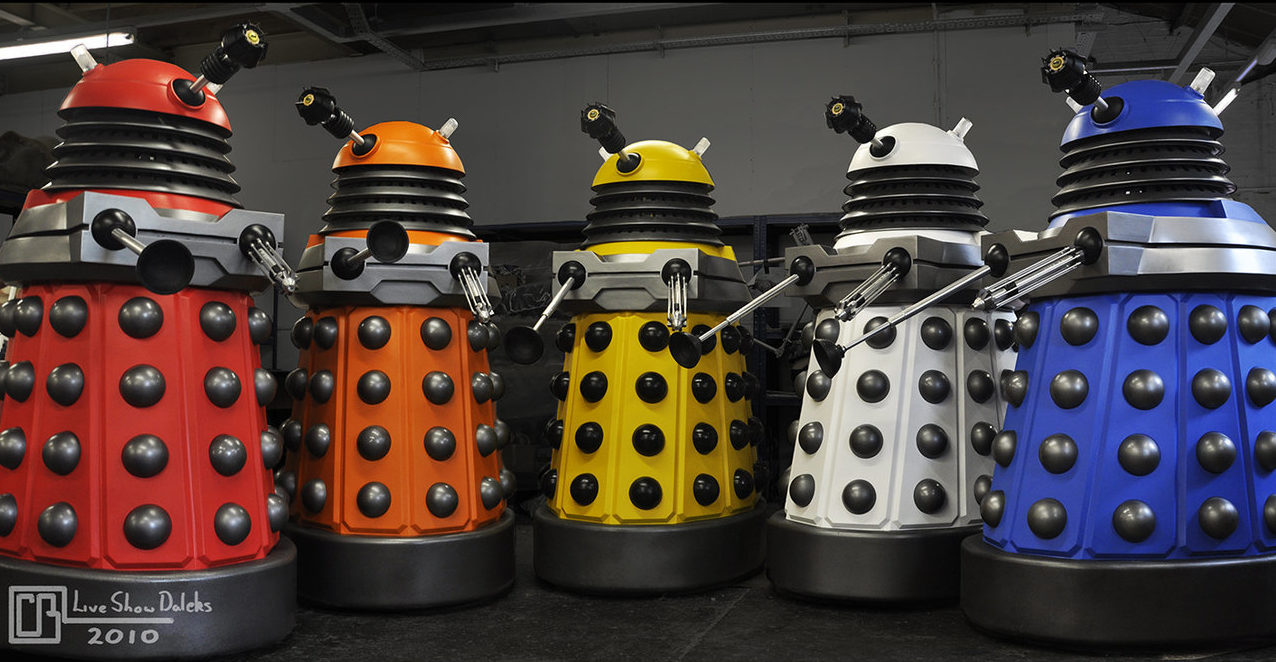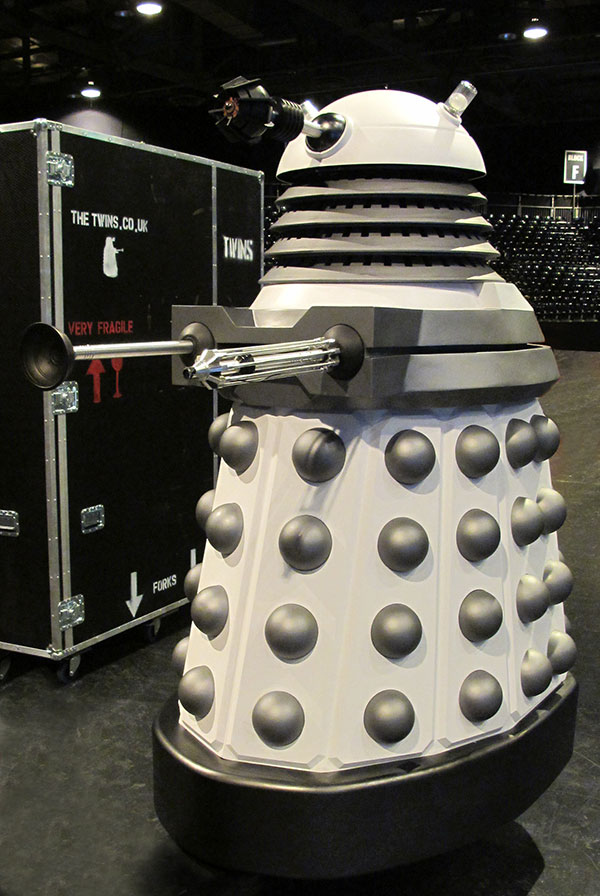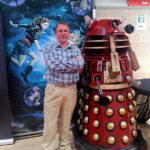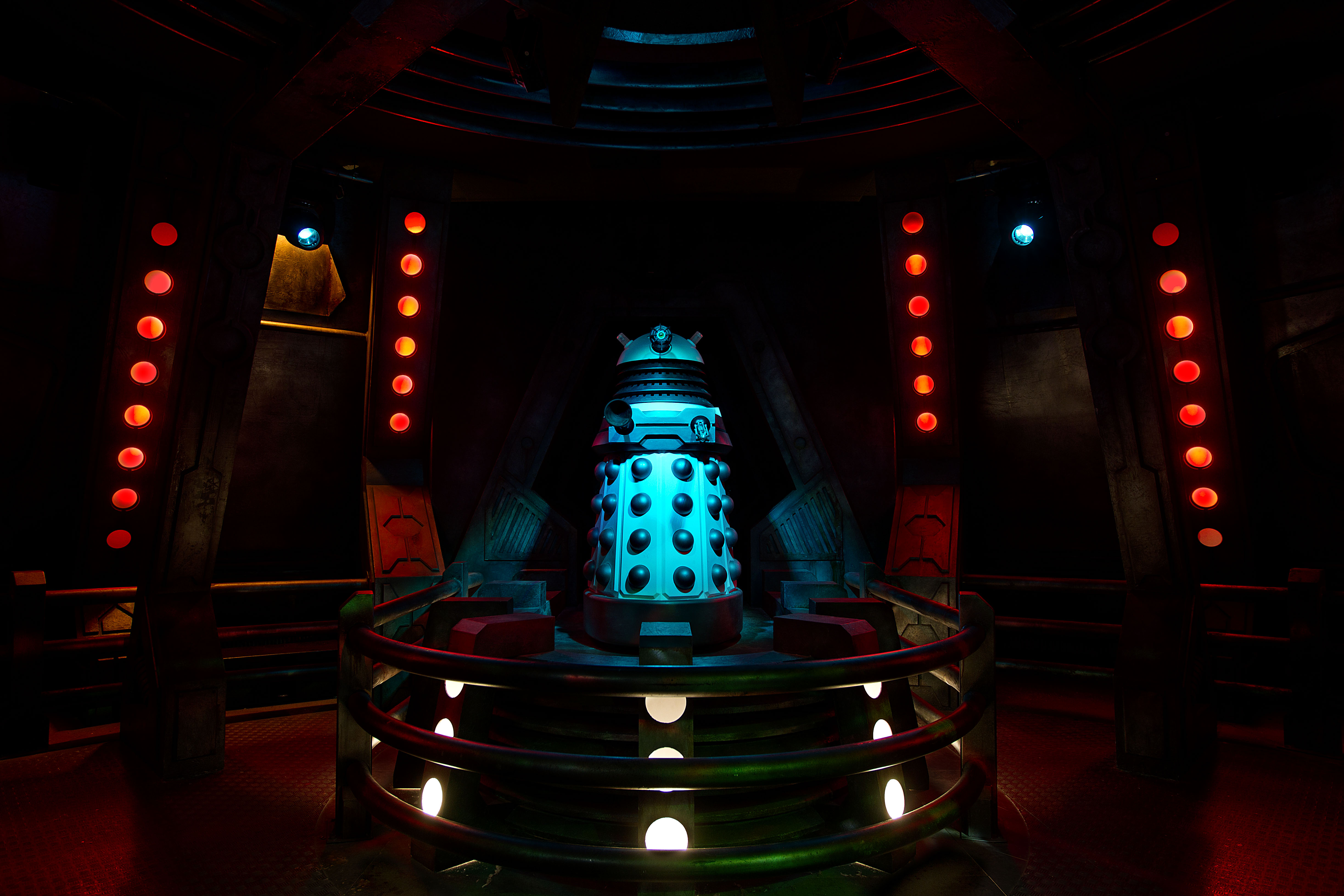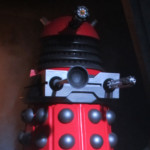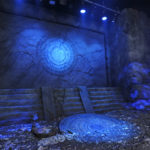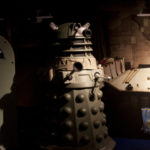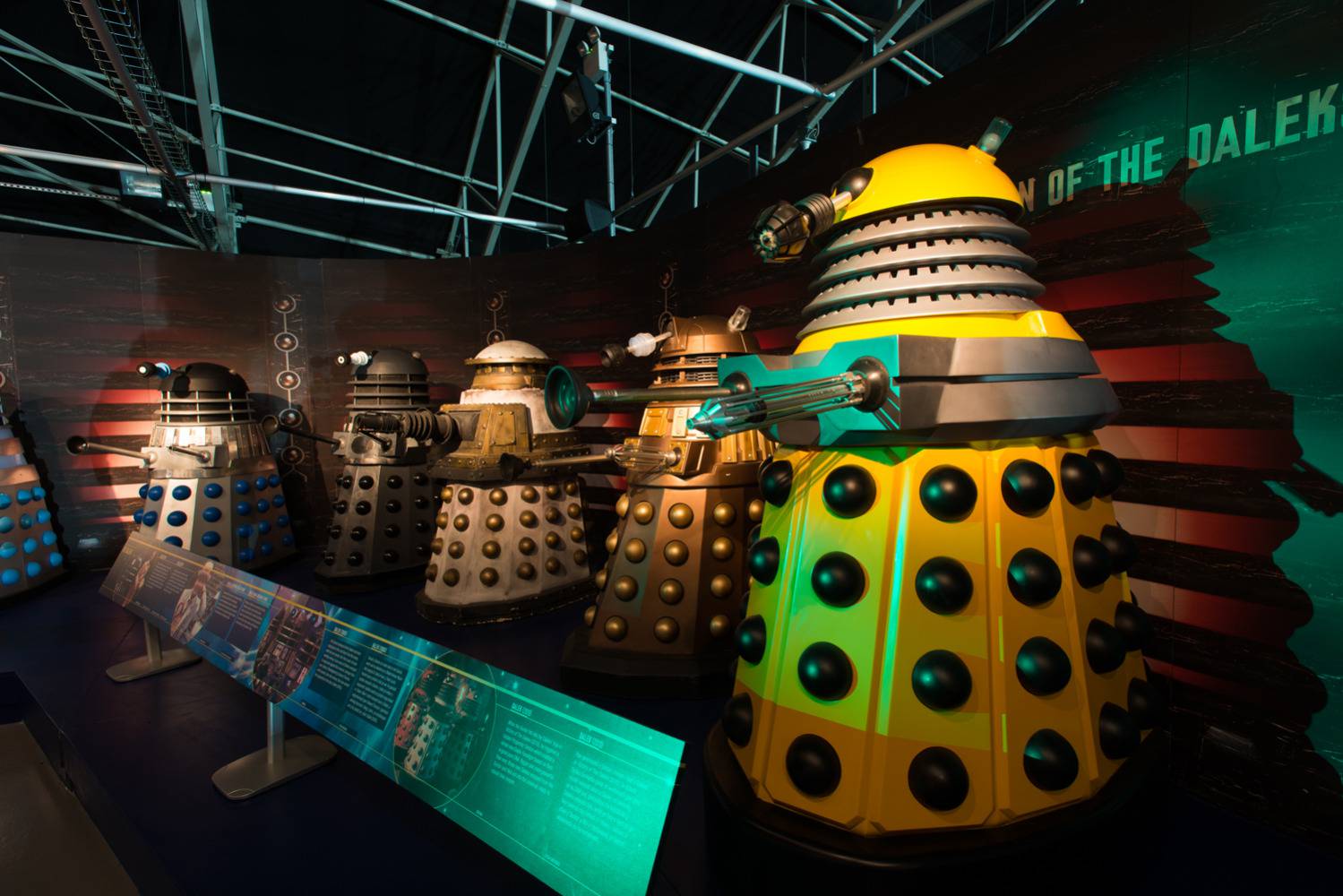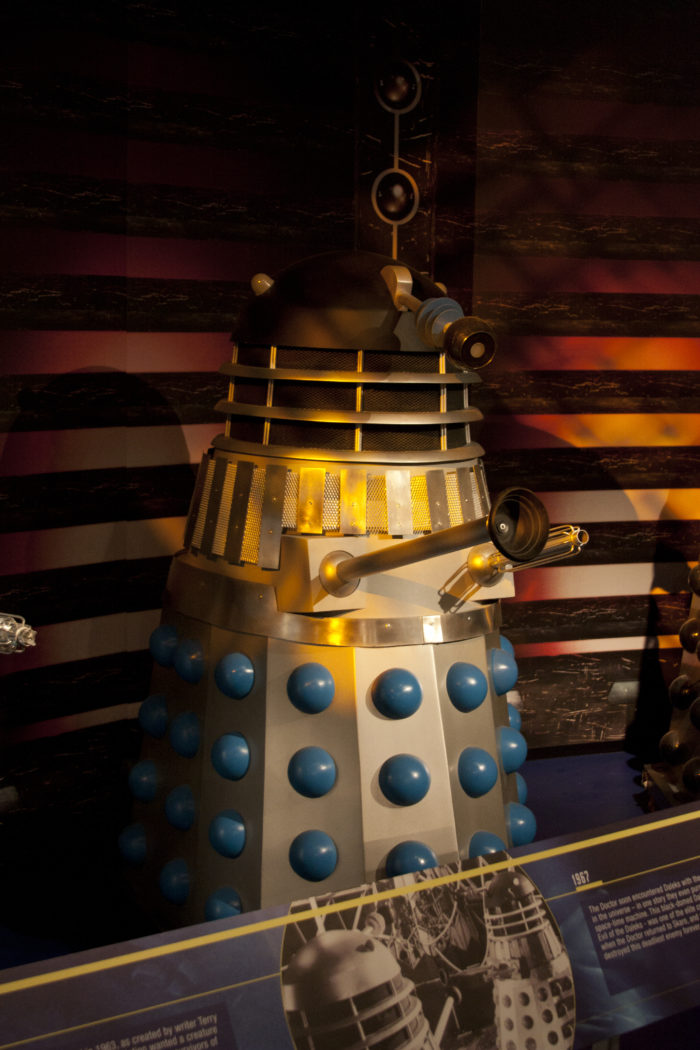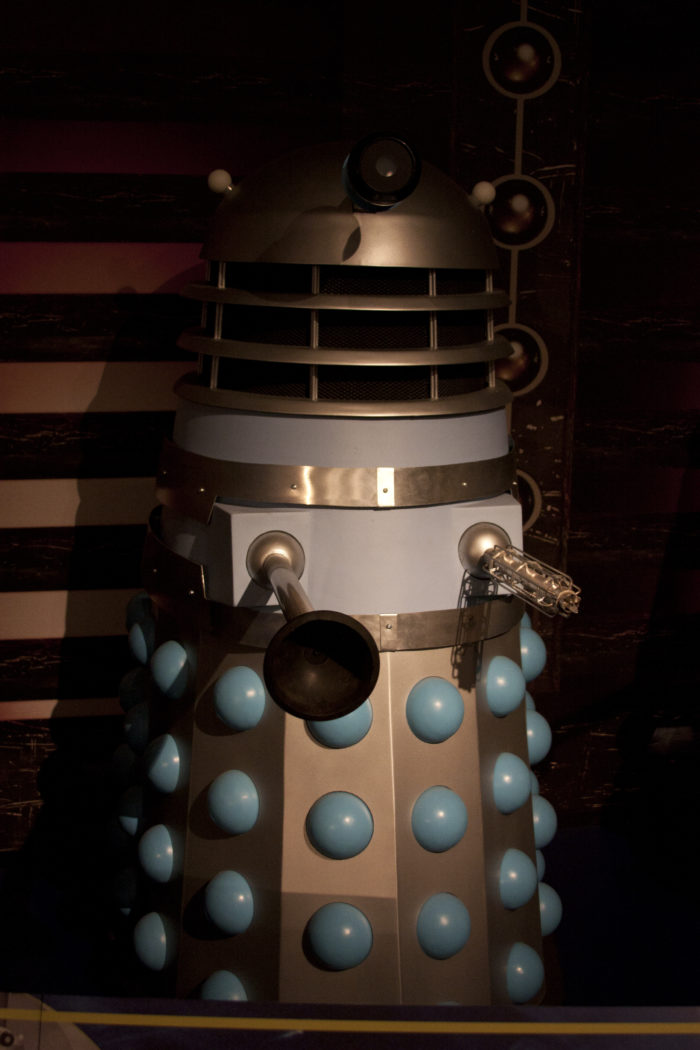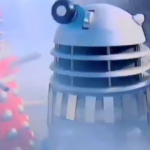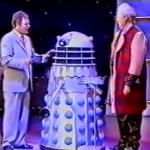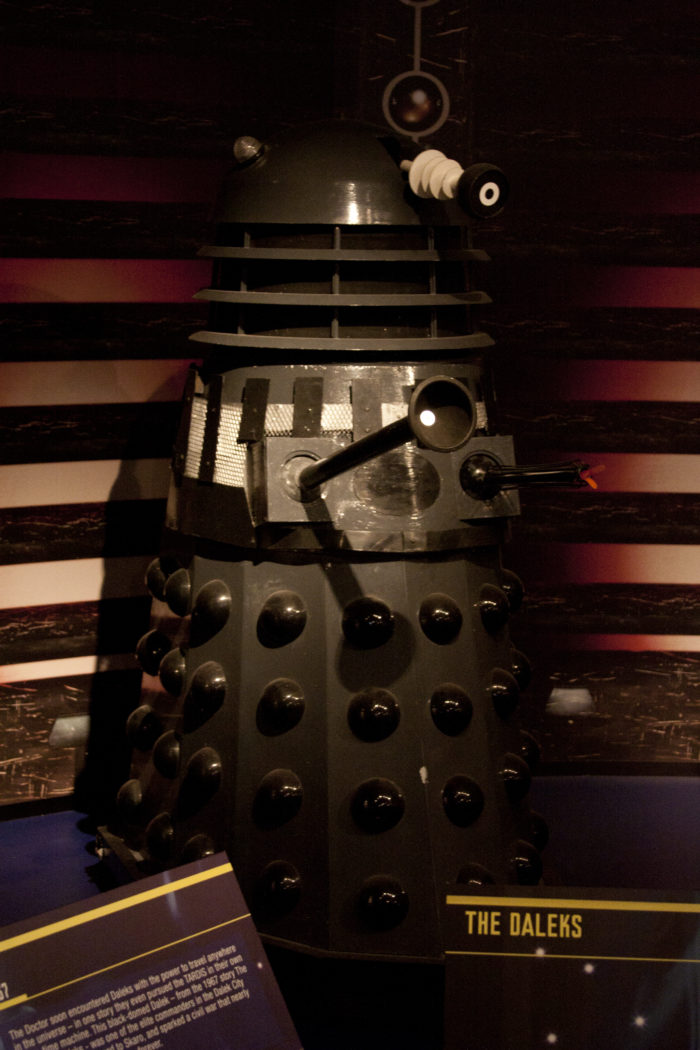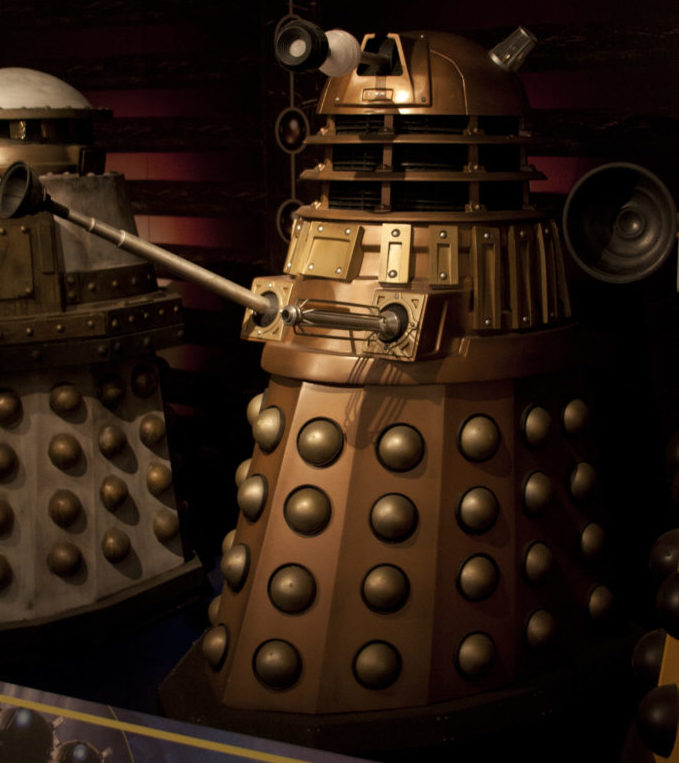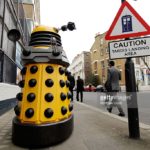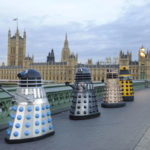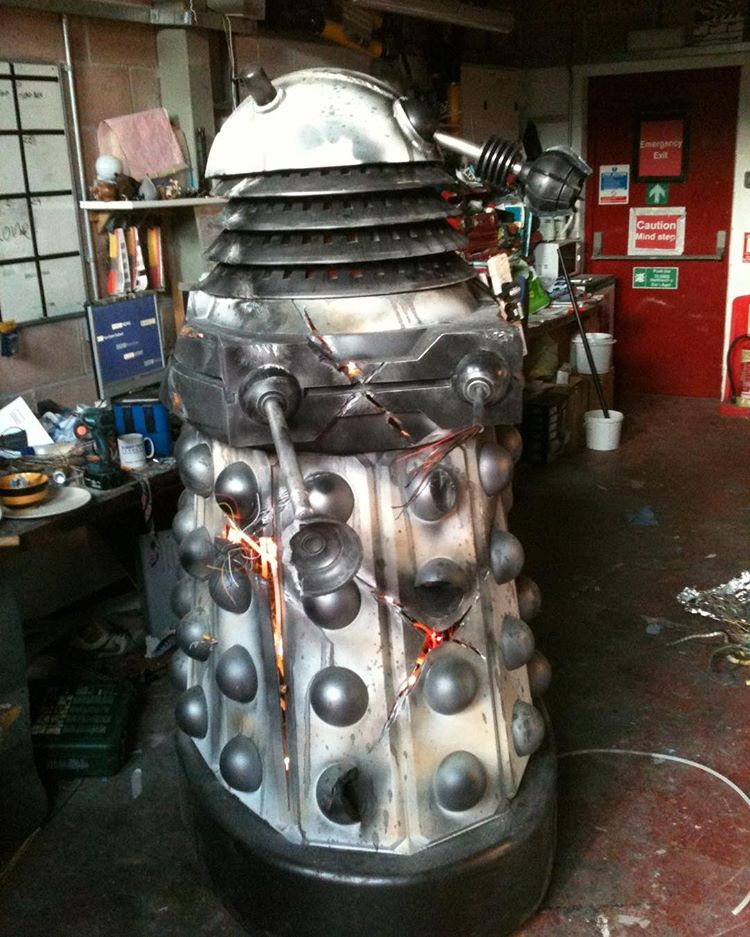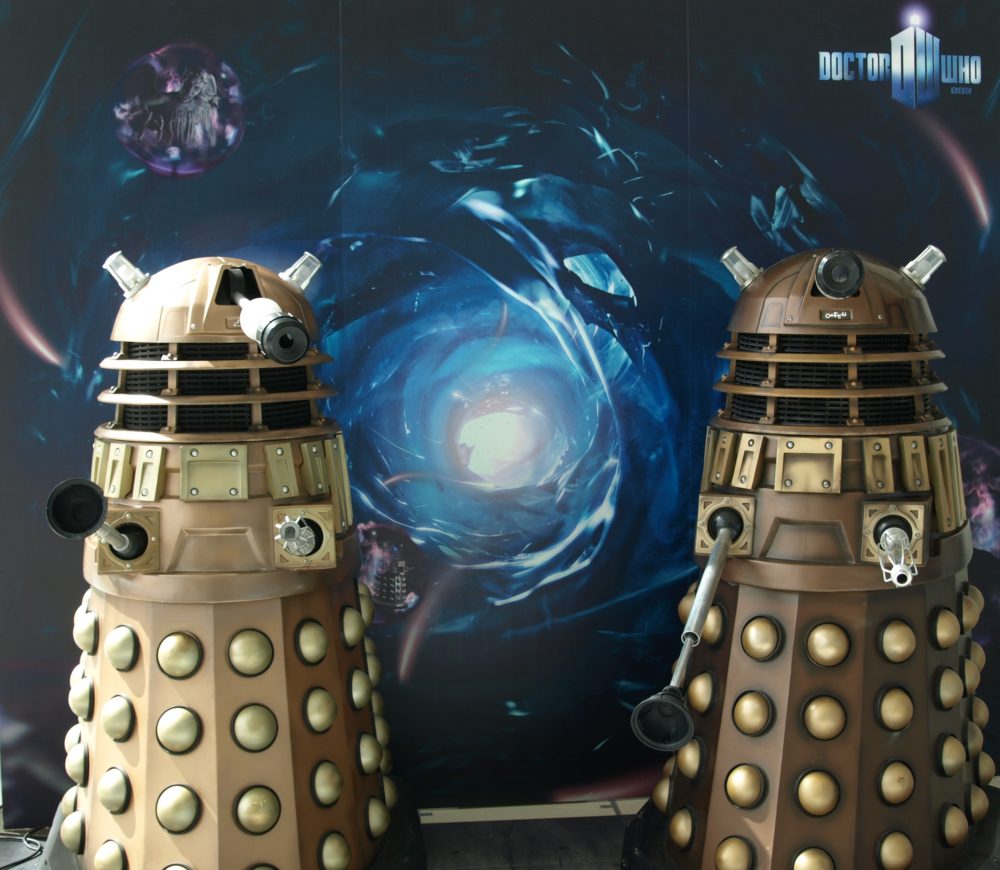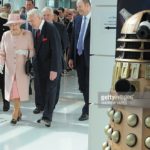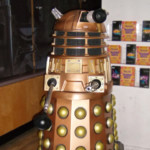Victory of the Daleks
Such is the nature of TV production that incoming showrunner, Steven Moffat, was planning 2010s Series Five as early as 2008. The timescale allowed, not only a complete season of scripts to be arranged, but also finding and casting a new Doctor and companion. With new executive producers Beth Willis and Piers Wenger on board, Moffat chose to ‘soft reboot’ the series in an attempt to give some fresh impetus to the show which, by the time his series aired, would be in its fifth year. Along with new lead actors, there would be a new interior and exterior for the TARDIS and a new set of titles and theme music.
Despite the changes, Moffat decided to follow a tried and tested formula for the structure of his first few stories. Russell T Davies had successfully opened Series One with a contemporary tale followed by trips to the future and past. Moffat’s opening stories followed this same pattern and he elected to use the Daleks in his historical tale. Moffat already had a basic vision of what he wanted and offered Mark Gatiss the chance to script it in September 2008. Gatiss had also written the historical tale, The Unquiet Dead, for Series One which had featured Charles Dickens and Moffat was keen to match the Doctor with another famous personality of the past. Gatiss’ brief from Moffat was “Winston Churchill and the Daleks!”
Gatiss was very excited to be writing for the Daleks and his final script took some inspiration from classic British war movies and elements from Power of the Daleks. With the ‘soft reboot’ in mind, Moffat and Gatiss also felt it was the perfect time to make some changes to the Daleks.
The New Paradigm
In the most recent televised Dalek story, it appeared the Daleks had been utterly defeated and so Gatiss engineered the plot of Victory of the Daleks so that a small collection of ravaged Daleks could ‘win’ and restore themselves to their full potential. As part of the ‘Victory’ of the title, the Daleks would become a ‘New Paradigm’ (or NPD) and their appearance change from previous designs.
Moffat and Gatiss were keen on the 1960s Dalek movies starring Peter Cushing, and wanted their new look Daleks to take some inspiration from the props made by Shawcraft for the films. Although the same basic design as the TV props was retained, the movie Dalek props had larger fenders and therefore stood much taller than their TV counterparts1. They were also finished in brighter colours, denoting various ranks. It was this, more imposing Dalek, that Moffat and Gatiss hoped to emulate.
Production Designer Ed Thomas assigned concept artist Peter McKinstry to the difficult task of creating something that was familiar, yet completely different. McKinstry explains that his brief was to give, “a complete overhaul of every element of the Dalek.” Although Steven Moffat noted that carte-blanche wasn’t being given to the designers, saying, “You can’t go too far with that design,” however the keynote was a “more frightening Dalek.”
Starting with the overall look, one factor to consider was a particular quibble that had been raised by the original designer of the Daleks himself, Ray Cusick. Way back in 1963, the casings had been designed not to betray any signs of contemporary methods of fabrication, so were smooth and metallic. This was not the case when the monsters returned in 2005. The fictional construction techniques depicted on the bronze props were not consistent with the futuristic technology of the Daleks.
McKinstry comments that, “all the screws and rivets, although they add detail, up close it’s very man-made looking. It didn’t make any sense in-universe. Why would the Daleks use 20th century screws and rivets to manufacture their travel machines?”
These dated adornments were therefore the first to go. “My approach was to intrude clean lines, so the Dalek would now look like alien technology – beyond our own. I wanted it to appear that there were no shut lines or access panels visible, and this would make them look solid – impregnable! The creature inside was sealed in completely and there was no way to get inside without using a huge amount of force. This was all to help them look more dangerous and imposing.”
Dangerous was very much the word as McKinstry turned his thoughts to ways in which the Daleks might be physically formidable. In 1989, Ray Cusick produced a redesign of his creations which included “razor-sharp retractable barbs” on the manipulator arm to stop humanoids wrestling with them as they had so often done in the past. By coincidence, a similar idea was introduced to the New Paradigm.
“I gave them razor sharp edges on their surfaces – a slightly raised blade running vertically along each skirt slat. The circular collars around the head were also meant to be sharp, and blades were also put on the eyestalk, making it physically dangerous to grab.”
Aside from the additional razor blade edges, the body generally remained true to the established shape. Changes to the detailing was what defined the new look. The geometry of the skirt was essentially unchanged but the panels became raised. The neck, whilst still a stack of rings, had an extra stage and became more like a louvre screen with vertical slits so the operator could see out. The dome became more curved and a channel was cut into the surface. The protruding lights on the head were made slightly sleeker and the large cowl at the front of the dome was removed in favour of a more slender eye pivot.
A change to the eye-stalk itself was suggested by Steven Moffat. In his notes he said, “Maybe inside the eyestalk we can see, held in grisly place, a REAL EYEBALL. Like the Dalek mutant has extruded itself up through the casing, and its REAL EYE sits at the end of the eyestalk. Not a lens this time, a quivering eye, a darting pupil. Bit horrid maybe. But Daleks ARE horrid, kids LIKE horrid.”
He also wanted to freshen them up with a new trick or two, saying, “Maybe they should DO something new. Is there any new, cool thing the Daleks could DO? Doesn’t have to be world-conquering – just a cool new feature.” This lead to the most significant difference from the earlier casings, as McKinstry explains:
“I suggested that the redesigned mid-section now extruded from the body to make the Dalek silhouette more muscular. The traditional plunger and gun could [rotate] round to the back of the machine where a panel might open up to reveal a new appendage.” Thus the evil creatures were provided with their cool new feature and, being Daleks, had one particular upgrade that was likely to pop out: “A weapon which would swing round to replace either the gun or the plunger.”
His proposal went down well. “The idea was met with enthusiasm!” It was a concept that actually harked back to a similar idea that was discarded in the original Dalek design.
Once the shape had been signed off, then came the tricky issue of the colour scheme arose. The designer himself favoured a conservative approach. “I suggested that we give the them very metallic surface detail,” says McKinstry. “I wanted them to actually look like they were made from Dalekanium.” – A fictional metal invented by the Daleks.
The show-runner Steven Moffat had his own vision though, providing the brief to the Art Department that the props should be: “Lovely, shiny, Fruit-Gum colours, all gleaming, like you want to lick them.”
Therefore, all five Daleks were finished in bright colours which, as per the 1960s Dalek movies, would denote the rank or function. Gatiss’ original ideas included gold, silver, black, blue and red, however, ultimately, these were changed after suggestions by James North. Gatiss furthered his new vision of the Daleks by actually giving the name of the rank on-screen.
In a change to the established colour of the Supreme Dalek, the leader was given a white finish. There was also a blue ‘Strategist’ and an orange ‘Scientist’. In another change from generally established continuity, the drone Dalek was also given a bright colour – in this case, red. Moffat suggested an ‘Eternal’ Dalek as a “cool” name but didn’t elaborate on its function. Gatiss suggested a yellow a black finish for the Dalek in a nod to a wasp which the pair thought was an amusing take on a pointless but dangerous creature2. Green and purple liveries were also suggested at the design stage, but ultimately rejected.
As with the new Dalek props of Series Four, the in-house team at Upper Boat Studios, headed by Penny Howarth, created the five new Dalek props. With no existing props to copy and to cast from, each mould and component had to be scratch built.
The pressure of the schedule was punishing and extra staff had to be taken on to complete the construction of the props. Some areas of the design had to be simplified to cope with the build process – the blade-like detailing on the skirt had to be tweaked in favour of just having extruded panels. With the ‘New Paradigm’ Daleks complete, the team turned their attention to location matters.
War of the Daleks
Filming began on 21st August 2009 in the bunker of the Joint Resilience Unit in Swansea with Andrew Gunn directing. The building had been a Ministry of Defence centre in the 1950s and was perfect for the setting.
The plot of the tale required the use of the standard bronze ‘New Series’ Daleks and, as with Power of the Daleks, the Daleks were duping the humans characters into believing they were in co-operation. In this case, scientist Bracewell, believed he had created the ‘Ironsides’ for Churchill and therefore the Daleks were given a new paint scheme to match the World War II setting.
Three ‘NSD’ props were required and with MT1 away at BBC Birmingham, it was NSD2 and NSD4 that were utilised for the initial scenes. They were both painted into a khaki green finish befitting the setting. Canvas utility belts were added to their shoulder sections that had various pockets and bags added to it suggesting the Daleks carried tools and bottles. The lights on the dome were also covered with canvas in a nod to ‘blacking out’ of light that was necessary during the war. ‘Union Jack’ stickers covered the usual ID tag area. The original idea had been to include a target design on the side of the Dalek as per the image that could be seen on a Spitfire. However, it was felt the image would distort on the hemispheres when not viewed from the side-on3.
Little extra work was carried out to the props as the upside-down slat on NSD2 (as seen in The Stolen Earth and Journey’s End) had not been corrected, however, a new plunger attachment was constructed to allow it to twist upwards, allowing a Dalek to carry a tray. Both Daleks had their necks incorrectly rotated at various times during filming.
Bracewell’s rooftop demonstration of the ‘Ironsides’ took place at the Glenmorgan Building in Cardiff on 27th August. NSD2 was the prop used here and its upside-down slat can be seen briefly beneath the canvas belt. Jacobs Market in Cardiff was the next location to be used on 28th and 29th August and included the scenes set in Bracewell’s lab. Both NSD props were used. NSD4 had the new sucker attachment fitted and was seen to carry a tray and offer tea. It also took the brunt of the Doctor’s attack with the large spanner.
NSD4 retained the plunger attachment to carry a file down a corridor outside the lab. This scene was recorded during filming at Brackla Bunkers in Bridgend on 31st August and 1st September.
On 2nd September, the team moved to the humidifier area of Freeman’s Cigar Factory in Penarth. After a thorough cleaning, the large room was perfect for use as the Daleks’ spacecraft, with its shiny steel walls and ceiling. Extra elements of set were added to help complete the illusion.
All the Daleks props were required here for the reveal of the new Daleks, including NSD5 that had been recalled from BBC Manchester. It remained in its bronze finish and its dome had the ID tag that was briefly seen up-close in The Waters of Mars.
New Dalek operators Jon Davey and Benjamin Ashley joined stalwarts Nicholas Pegg and Barnaby Edwards. This was the first use for the ‘New Paradigm’ Daleks. Their first reveal included a tricky manoeuvre which required negotiating a ramp whilst blinded by smoke. This wasn’t aided by the weight of the props which, the operators noted, was somewhat heavier than the standard Dalek props. They also required a different technique for moving the prop around compared to the smaller bronze Daleks4. The rest of the filmed sequences included fairly standard Dalek fare and despite the build up for the new Daleks, they remained fairly static and didn’t show anything of the proposed new feature.
Nick Briggs had provided every Dalek voice since 2005 and it was his task to provide something a little different for the New Paradigm. “The Supreme has a much gruffer voice which is more taxing.” The final voice was realised with a different modulation with a layer of distortion.
Victory of the Daleks was transmitted on the 17th April 2010 but the Daleks were planned to make a return later in the season.
Turned To Stone
Moffat’s first season included a complicated arc that was partially resolved in the season’s finale episodes – The Pandorica Opens and The Big Bang. The tale included a wish list of “every monster he has ever faced” that Moffat wished to see confront the Doctor. Whilst the list ultimately had to be scaled down due to cost, the public would expect the Daleks to be heading such a gathering of monsters and were retained.
At the denouement of The Pandorica Opens, three of the new Dalek props appear alongside the monster menagerie. The props were the white ‘Supreme’, the Red ‘Drone and the yellow ‘Eternal’. The choice of props for these scenes was actually limited because the two remaining props were required for the following episode The Big Bang and needed a complete new look…
The story required stone Daleks as a result of the end of the universe that occurred during the tale. One of the two Daleks also needed to be a working prop and rather than fabricating two new Daleks, the decision was made to convert two of the existing NPD props. The blue and orange Daleks were covered in a thick substance that resembled stone but still allowed the various components to move. Various cracks and dents were made in the sides of the props to complete the illusion that it was ancient stone. The decision to cover the expensive props in the hard substance effectively ended their use as normal Daleks in the future.
The stone Daleks first featured as exhibits in the ‘National Museum’. This was filmed at Brangwyn Hall in Swansea in January 2010. The various scenes included one of the stone Daleks coming back to life and eventually ‘exterminating’ the Doctor. This was performed by the blue NPD5.
In February, the ‘Underhenge’ scenes were filmed for both episodes. To date, it was the largest set ever used in Doctor Who. The scenes required all five of the NPD Daleks. The two ‘stone’ Daleks were used when the Doctor was released from the Pandorica after the destruction of the universe.
The finale episodes were transmitted on the 19th and 26th June 2010.
Sweet Daleks
Such is the nature of fandom, of any popular film or TV series, that any small change to an established feature is noted and debated to the Nth degree. The New Paradigm Daleks received a particularly brutal attack from fans of the Daleks. Doctor Who Magazine even devoted an article to the subject in issue 431, stating for and against viewpoints.
Many disliked their size, terming the new Dalek ‘Fatleks’ and many thought they had a clumsy design with each section out of scale with the last. The weapons hatch on the rear came in for particular attention, seemingly giving the Dalek a hunchback.
To many, it was a paradoxical and confusing design. On one hand, it achieved the bigger and more dangerous alien look but matched it with colours that “kids should want to go up and lick.”6 For them, the colours were slightly comical and were completely at odds with what was trying to be achieved.
However, not every fan disliked them and children in particular seemed to be impressed with the design. And, as it happened, to the general public they were… Daleks.
Designer Peter McKinstry reflected, “The issue with this kind of brief is when you change things too much on the Dalek it just stops looking like a Dalek.” But Gatiss himself was more affectionate towards them. “I love absolutely everything about them … they are everything I wanted them to be, except the hump. Honestly look at them what’s not to love. They are so beautiful. I can understand people not liking that [hump] but what I don’t understand is that seems to have taken over people’s opinion of the entire thing. It’s not all about the hump.”
Despite the general ire directed towards the Daleks, Matt Smith’s first season as the Doctor was a resounding success. The ‘soft reboot’ had worked and the show’s popularity showed no signs of faltering and even started to gain viewers in the generally tricky North American market. Dalek merchandise was also given a boost with manufacturers latching onto a whole new colourful opportunity.
Re-election of the Daleks
A new Doctor and companion is always guaranteed to generate huge publicity, but just two weeks after a Radio Times cover featuring Matt Smith and Karen Gillan, Doctor Who featured again. The Daleks returning to the show was always big news and in this case, with a major design change, the temptation for another Doctor Who themed cover so soon after the last was too hard to resist for the Radio Times. As had happened in 2005 with Dalek, the broadcast of Victory of the Daleks was set to coincide with a General Election in the UK. The Radio Times took full advantage of the coincidence once again, and came up with a series of three different covers to show off the new look Daleks. The red ‘Drone’, blue ‘Strategist’ and yellow ‘Eternal’ all had one cover each and represented the colours of the main three political parties in the UK. They were each super imposed over a slightly reworked version of the 2005 cover featuring Westminster Bridge and the Houses of Parliament.
The Doctor Who ‘Up Close’ exhibition in Cardiff was still getting regular visitors and its animated Dalek display featuring the Supreme Dalek from Series Four continued into 2010. Soon after Victory of the Daleks had transmitted, NSD4 in its khaki livery was added to a separate display. Surprisingly, unlike the exhibition ‘copies’, the screen prop was positioned so it was very easy for the general public to get close to and touch.
The Lands End exhibit also saw some additions in early 2010. With the closure of the Kelvingrove and Coventry Transport Museum displays, a number of exhibition props became available. TPE-EC1 was moved into a new display outside of the animated area. It was fitted to its short track as it was in Coventry. The animated display also saw a new addition in the shape of Dalek Caan. This wasn’t quite the full screen-used prop though. The ‘open-Dalek’ section that had featured in Series One and several exhibitions thereafter, was fitted to the hero Caan skirt. It was augmented with the hero gun and arm box panels and neck cage. A ‘distressed’ gun was added into the gun socket instead of the valuable hero gun. As with the main Daleks, the mutant was given some movement and appeared to bounce up and down during the display.
During the opening months of 2010, the BBC had been planning a range of new free interactive computer games called “Doctor Who: The Adventure Games.” The launch was timed to coincide with the transmission of Series Five in June. But in April, a number of school children in Sheffield were given the chance to preview the first episode which was entitled “City of the Daleks”. Seizing the chance of a promotion, the three remaining NPDs made their first public outing and were on display for the public and media alike. As this was prior to the transmission of the finale episodes, everyone was unaware as to why only three of the Daleks were attending. In August, The red ‘Drone’ Dalek also made an appearance on the BBC stand at ‘National Eisteddfod’ in Ebbw Vale.
The BBCs ongoing travelling exhibitions continued when a new display was set-up at the ‘Centre For Life’ in Newcastle in May 2010. It was a similar display to all those that had gone before, therefore featuring mainly ‘New Series’ items. Another animated Dalek display was the centrepiece, and with a number of exhibition props available, it was the largest set seen yet. The Specialist Models made NSD-W featured alongside TPE-SP, TPE-SEC2, TPE-EC2 and a further static bronze Dalek that lurked in the dark next to the animated Davros. The display ran along the lines of previous displays with moving Daleks firing lasers and Sec rising up from the floor. NSD2, in its khaki livery, also featured in the main display area.
This was the last display to be arranged by Martin Wilkie’s Experience Design and brought to an end the long association that Wilkie had with Doctor Who exhibitions. A time that stretched back to the Longleat and Blackpool exhibition days.
So Close You Can Feel Their Fire!
After very successful live music events in both 2006 and 2008, another Prom concert was planned for 2010 at the Albert Hall. The basic format followed the same pattern as the 2008 show, although this time Matt Smith actually appeared live, as The Doctor, during the show. The Daleks had their own musical section and to introduce it, NSD4 was sent from the Cardiff exhibition, still in its ‘Victory’ livery, to interrupt Karen Gillan who was onstage at the time. NSD4 rose from the centre of the auditorium suggesting it was a soldier of the audience and asking if they wanted tea. The Dalek itself was interrupted from the stage by the white Supreme NPD who commanded it to leave as it was inferior. The new white Dalek received a rapturous welcome from the audience. The show was performed on 24th and 25th July.
But the Prom wouldn’t be the only live musical show that happened in 2010. After the huge success of the various concerts since 2006, BBC Worldwide suggested a touring show. They approached experienced show director, Will Brenton, with a view to taking on the show. He suggested a more narrative element for the show rather than a series of musical passages. During development, Steven Moffat recalled the 1973 tale Carnival of Monsters, and suggested that elements of this story could be used in the show. Gareth Roberts, whom had written for Series Five, co-wrote a script with Brenton which included an interstellar showman and his ‘incredible machine.’ Matt Smith was not available to appear live and so he pre-filmed sections that the live actors performed with. Nigel Planer of The Young Ones fame was the main live star, playing the showman Vorgenson.
Many of the shows most recent enemies appeared during the show, but of course, the Daleks were the main enemies that the audience craved to see. They were held back for the second half of the show where they battled the Cybermen and, at the finale, a levitating Dalek Supreme would appear from the side of the stage!
With the New Paradigm now established on screen, it was these Daleks that would appear in the show rather than the bronze ‘Time War’ Daleks. After the Series Five finale, the main TV prop numbers were down to three and therefore necessary to construct new props. The task was handed to Millennium FX rather than the in-house team in Cardiff. The chance was taken to make the props lighter than the TV versions to aid the operators who had to make a number of choreographed manoeuvres onstage. Charlie Bluett and Harvey Smith of Millennium FX created five near exact copies of the original five NPDs from the original moulds. There were only two small differences that gave away the fact that these props did not originate from the original construction team – the fleshy part of the eye differed slightly in its appearance and a small ‘curtain’ of black material was added to the underside of the fender to help hide the operators feet on stage.
One more Dalek was also constructed for the show – the special ‘flying’ version of the Supreme Dalek that was needed for the finale. TwinsFX were hired to invent of number of the onstage effects for the show, including the flying Dalek. As the method of flying the Dalek needed its own special mechanism they made the Dalek themselves. They were also allowed access to the original BBC moulds to create the main casing. They then constructed copies of the eye, arm and gun in-house to fit to the prop7.
The tour ran in October and November 2010 in nine cities and was deemed a huge success. There was extensive promotion of the show and the TwinsFX Dalek made a number of local TV and media appearances. One of the bigger promotional items was on ITVs breakfast show Daybreak in late October. ‘Voice of the Daleks’ Nick Briggs was interviewed on the show alongside, an Ood, a Cyberman and the TV hero Supreme Dalek. The TV hero yellow Eternal Dalek made an appearance at the Première in London.
With the Series Five season completed, and no plans for the Daleks in the 2010 Christmas Special, fans thought they had seen the last of the Daleks for some time. Steven Moffat even started to tease the press that he would be resting them for the foreseeable future. However, they did get a cameo Christmas appearance when the white Supreme prop featured in the Christmas trailers for David Walliams and Matt Lucas’ new comedy show Come Fly With Me. Both were fans of the show and had even employed Tom Baker as narrator for their hugely popular show – Little Britain.
A New Experience
In 2011, the BBC decided to take all future Doctor Who exhibitions in-house. They envisioned a single, larger scale and more immersive display more in tune with modern audiences whom were getting used to to displays that were more interactive. Therefore the existing exhibitions were all closed. The Newcastle display at the ‘Centre for Life’ was closed on October 2010, Lands End in January 2011 and the Cardiff ‘Up Close’ in March. The various displays and props were placed into storage. The Series Four Supreme Dalek, that had been in the animated display at Cardiff, didn’t get packed away however as it went straight out on the road again for the BBC Wales annual roadshow.
The BBC employed Sarner International to help design their newly planned display. Sarner were experienced in creating theme parks and helped to bring a depth to the display unseen before. Upon arrival, visitors would be treated to a film featuring elements Series Five, before the whole wall opened with the ‘crack’ that featured in the arc of the series. The visitors were then walked straight into an interactive adventure with their guide who became part of the show. Matt Smith featured in pre-filmed sections and appeared to interact with the guide. Along the way, visitors would be guided through various sets relating to the show which included a graveyard with Weeping Angels, a full scale recreation of the TARDIS set (complete with moving floor) and a Dalek Spacecraft…
Attendees were plunged into a full scale war between the New Paradigm Daleks and the old ‘Time War’ Daleks. The set depicted the NPD craft and included three animated Dalek props. The battle was displayed on several large screens simulating the windows of the spacecraft. As with the ‘Live’ show, the Daleks were created by Millennium FX. They supplied a white ‘Supreme’, and two red ‘Drones’. Each Dalek moved into the set on a track and Nick Briggs provided the pre-recorded vocals. The brief view of ‘Time War’ Daleks on the screens was possibly the first indication we hadn’t actually seen the last of them.
Moving on, the visitors would then enter a 3D cinema room. The screen was initially covered with a design that resembled the Pandorica. Next to the screen was one of the stone Daleks used in The Big Bang. This was the orange ‘Scientist’ prop.
After leaving the interactive section, attendees then entered the main hall. They had been treated to a Victory of the Daleks display, that included NSD4, while waiting to enter the interactive section but here there was a full display of Daleks from across the whole history of the show. It began with the ‘exhibition’ Davros that had last been seen in Newcastle. This was followed by two 1960s style Daleks.
These Daleks belong to Andrew Beech who works as Content Supervisor for live Doctor Who events and is Curator of the Doctor Who Experience. When Doctor Who was revived in 2004/05, Beech owned a batch of 60s-era replica Daleks, originally constructed by Steve Allen, Alistair Lock and Dave Brian that had been made over a period of time from early 1990s. Two were cannibalised by Mike Tucker and his team to build the original bronze Daleks for the Series One episode Dalek.
Two remaining Chase-style props eventually joined the London Doctor Who Experience following some refurbishment. The work was carried out by Mike Tucker who was asked to change the props (termed AB1 and AB2) to create a time-line of Dalek development.
To make AB1 a little more distinctive than the typical 1960s “drones”, Tucker painted the dome black and fitted it with new lights which turned it into one of the props from Evil of the Daleks. During that adventure, the black dome served to distinguish them from the human Daleks who had silver heads, but in fictional terms their status is a little unclear. They’re referred to as “Black Daleks”, which was previously a term applied solely to one commander per story, but in Evil there are many of these black domes. They are often referred to as “Throne Room Daleks”, because they are so strongly associated with the Emperor Dalek but they were never exclusively seen there.
Dalek AB2 was rolled back even further so that it represented an even earlier model, that of the first Dalek story, which involved removing the slats and mesh, and providing it with ping-pong ball lights. The skirt was also adjusted so that the hemispheres pushed through from the inside rather than being screwed to the outside as per Dalek AB1.
The prop had received two early TV appearances before the refurbishment and settlement into its new home. In the summer of 1992, the BBC ran a live magazine show from The National Garden Show in Ebbw Vale. Starring Caron Keating (of Blue Peter fame), Linda Mitchell and a young Rob Brydon, the show featured a mix of the usual daytime fare. One such item was a preview of original Doctor Who props going up for auction at Bonhams in August of that year. Beech was interviewed about the sale and brought his Dalek along to star in the fun item where Brydon took on the role of a hapless version of the Doctor. Elisabeth Sladen also featured in the item. Another exciting element was a rare appearance by second movie Dalek, Dalek AARUII 2-5 which was going to be included in the auction itself.
Dalek AB2s second appearance was on the BBCs popular Saturday evening game show – The Generation Game. The segment required guests to guess the auction prices of various Doctor Who props. Colin Baker was also on hand to give some details of the props to presenter Jim Davidson. The Dalek was valued at some £16,000!
Beech’s Daleks were followed in the line up by an incredible replica of Dalek One-7 in its time as a ‘Resurrection’ Dalek from 1984. The prop was created by Mark Barton Hill and had previously been seen at the Longleat Exhibition when the Dalek was recreating Dalek One-7 in its ‘Five Doctors’ form. The replica prop even included the blocks of wood that were protruding from beneath the front slats on the original prop at that time. Barton Hill had a reputation for high quality prop building and restoration and had performed the restoration of the ‘Yardley-Jones’ TARDIS prop that was also featuring in the main hall.
The Special Weapons Dalek was next in the alien line-up. This prop had served in several exhibitions since its only TV appearance in Remembrance of the Daleks. It had last been seen at the second Blackpool exhibition where it was looking very worse for wear and missing a number of sections of its gun. Mike Tucker was commissioned to restore the prop back to it original state which included using a number of new parts.
The ‘Time War’ Daleks featured next, and with a number of exhibition props now free to use after the travelling versions had stopped, it was an arbitrary choice as to which was used. As it conspired, it was mix of the two Earls Court Daleks that eventually featured. The upper half of TPE-EC2 was matched with the skirt of TPE-EC1 to create the final prop TPE – EC2/EC18.
The New Paradigm Daleks were represented by the hero yellow ‘Eternal’ Dalek which had also starred for the press in and around Kensington in a special photoshoot to promote the opening of the Exhibition.
The Doctor Who Experience opened in February 2011 at Olympia in London and ran for a year. In July, another special photoshoot was arranged to recreate the famous pictures taken on Westminster Bridge for The Daleks Invasion of Earth. Four of the Dalek ‘timeline’ props were removed from the Experience for the shoot – those being Dalek AB1, TPE-EC2/EC1, Mark Barton Hill’s Dalek One-7 replica and the ‘Eternal’ NPD.
For a brief time before the closure, NSD2 joined NSD4 in the ‘Victory’ display. It wasn’t the end of the Experience though. It was reopened in July 2012 next to the Roath Lock studios in Cardiff, which was to be the new home of Doctor Who.
Queen of the Daleks
Despite Steven Moffat’s insistence that the Daleks were being rested for Series Six, they did get a small cameo in the opening moments of the finale – The Wedding of River Song. The short sequence featured The Doctor retrieving information from the data coil of a Dalek. For the scene, the ‘in-house’ team distressed the original white Supreme NPD9 after which it featured a number of cracks in its casing through which came light from internal bulbs, suggesting you could see into the workings of the Dalek. The episode was transmitted on 1st October 2011.
Since Doctor Who’s return in 2005, spectacular musical shows were becoming a common event and although there was no Doctor Who Prom arranged for 2012, Australia would get its own set of concerts based on a similar concept to the Prom events. The ‘Symphonic Spectacular’ took place on the 4th February in Melbourne and several concerts in December in Sydney. They were hosted by stars Alex Kingston and Mark Williams. The NPDs created for the ‘Live’ show in 2010 were transported over to Australia where they would promote and perform.
In March 2012, the BBC was in the process of transferring a number of it operations from London and New Broadcasting House in Manchester to a new site at Media City in Salford. After ‘Victory’ had completed filming, NSD5 had returned to BBC Manchester which had become its adopted home for a number or months. The Dalek was also transferred over to Media City to stand in the lobby for visitors.
But it was joined by another Dalek. TPE-TVC, which had seen screen use on the Andrew Marr show in 2008, was transferred from Television Centre to the new location. The Queen made an official visit to Media City on 23rd March and the paparazzi seized the chance to get a number of pictures as she passed the two props.
To replace the Dalek at Television Centre, another mix of exhibition props was drafted in. It consisted of part ‘Earls Court’ and part ‘Spaceport’ prop sections – TPE EC1/SP. As before, the Dalek was available for visitors on the TVC tour to pose with for photo opportunities.
With the ‘rest’ season complete, Moffat had plans to bring back the Daleks for Series Seven. A story that promised “Every Dalek Ever!” Excitement surrounding the hype was palpable, but was all as it seemed…
-
With the exception of the props in ‘Dalek Invasion of Earth‘ which also had large fenders
-
Mark Gatiss – DWM 431
-
Mark Gatiss – DVD commentary
-
Barnaby Edwards – DWM 423
-
Holes in the stone effect covering reveal the orange Dalek was the static stone Dalek
-
Steven Moffat – DWM 421
-
Many thanks to TwinsFX for their help with their ‘flying’ Dalek – thetwinsfx.co.uk
-
Dalek ID for mixed props – the first code denotes the upper half, the second code is the skirt.
-
As confirmed by Alan Hardy of the BBC Cardiff Props department – props_guy2000 (Instagram)
